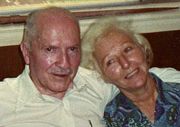Robert A. Heinlein
Robert Anson Heinlein (July 7, 1907–May 8, 1988) was American author of science fiction and winner of four Hugos for the best science fiction novel of the year (a record recently equaled by Lois McMaster Bujold but not yet beaten). He was the Writer Guest of Honor at the World Science Fiction Conventions of 1941, 1961, and 1976, and received the first Grand Master Award given by the Science Fiction Writers of America. For many years, he, Isaac Asimov, and Arthur C. Clarke were known as the Big Three of science fiction. His best-known works include Starship Troopers (1959), Stranger in a Strange Land (1961), and The Moon Is a Harsh Mistress (1966). Heinlein also wrote a little fantasy fiction and some non-fiction and was also an engineer and a naval officer.
Locus, the trade journal of the science-fiction world, devoted most of its August, 2007, issue to "celebrating the Robert A. Heinlein centennial"; in an article called "Yesterday's Tomorrows," Graham Sleight writes about Heinlein's debut as a writer in 1939 and of his importance to the field:[1]
Rereading Heinlein's stories now in conjunction with those of his contemporaries in Astounding—"Doc" Smith, say—is to be struck by how much he was in command, right from the start. He somehow found, or brought into being, a language for describing the future so much more sophisticated than anything else that had been seen. How could you not pledge allegiance to it? Watching his emergence in those first few stories must have been like seeing an adult walking into a room full of children.
Educated at the United States Naval Academy, Heinlein hoped to be a career officer; he was discharged, against his will, for medical reasons in 1934.
His work's dominant themes are the importance of freedom and creativity, with many of his protagonists rising from obscurity through their own wits, or battling for freedom against collective entities. As a result, he is high on the list of authors favored by libertarians. His work also often reflects such martial virtues as patriotism and loyalty.
Life
Early years
Robert Heinlein was born on July 7th, 1907 in Butler Missouri, the third of Bam Lyle and Rex Ivor Heinlein's seven children. At the time Heinlein's family was living with his grandfather, Dr. Alva E. Lyle. They soon moved to Kansas City, Missouri where Heinlein would grow up. After graduating from Kansas City High School, he set about applying to Annapolis, in the meantime studying at Kansas City Junior College. Despite facing the obstacle of having an older brother who had already entered the academy, Heinlein was able to gather enough recommendations to obtain an appointment.
Heinlein entered the United States Naval Academy in 1925. He would graduate in 1929, 20th in a class of 243. On graduation, Heinlein was assigned to an aircraft carrier, the U.S.S. Lexington. After a few years on the Lexington, he was rotated to a destroyer, the Roper. It was at this time that Heinlein came down with Tuberculosis, resulting in his discharge.
California and politics
On his discharge from the Navy, Heinlein spent time in Colorado and California. During this time Heinlein dabbled in various careers such as silver mining and real estate. He briefly attempted to continue his studies at UCLA. He also got involved, at the opposite end of the political spectrum from what his later work would suggest, in politics. Heinlein was a supporter of Upton Sinclair's left wing EPIC movement and launched a failed bid for the nomination in a Democratic primary.
A full-time writer
Heinlein launched his professional career in 1939, selling his first stories to John W. Campbell, Jr., the Editor of Astounding Science-Fiction. When World War II broke out he first made himself available to the Navy and then went to work as a civilian engineer at the Naval Air Experimental Station near Philadelphia. When the war ended he would return to writing full time.
Later years
Heinlein would become one of the leading figures of science fiction winning the genre's top honor, the Hugo award four times times. His work would also become known in the mainstream media. He published stories and articles in popular magazines such as the Saturday Evening Post and Collier's. He was a guest commentator for CBS's coverage of the Apollo 11 mission.
References
- ↑ "Yesterday's Tomorrows", by Graham Sleigh, Locus, The Magazine of the Science Fiction & Fantasy Field, Issue 559, Vol. 59, No. 2, page 37
